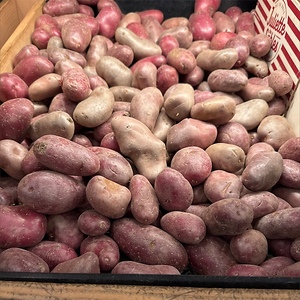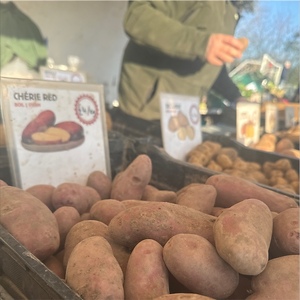


Cherie Potatoes
Estimated Inventory, lb : 0
Description/Taste
Cherie potatoes vary in size and shape, depending on the growing region and cultivation conditions, but are generally a small to medium-sized varietal, averaging 4.5 to 5 centimeters in diameter and 11 to 12 centimeters in length. The tubers have a uniform, elongated, oval, to oblong shape and may occasionally feature a few small bumps across the surface. The skin is semi-thin, smooth, and taut, showcasing a red-pink hue with shallow eyes that do not affect the shape of the tuber. The skin also occasionally has flaky, textured patches that peel from the surface and a few dark brown-grey markings and spots. Underneath the skin, the yellow to cream-colored flesh is slippery, firm, and hard when raw. The flesh is known for its low starch content and waxy nature. When cooked, Cherie potatoes develop a creamy, smooth, and dense consistency. Cherie potatoes are only edible after cooking and have a sweet, earthy, and nutty taste with chestnut-like nuances.
Seasons/Availability
Cherie potatoes are available in the summer, typically between June through August, depending on their sowing date.
Current Facts
Cherie potatoes, botanically classified as Solanum tuberosum, are a French variety belonging to the Solanaceae or nightshade family. The uniform, elongated tubers are categorized as an early or second early potato, meaning they are harvested approximately 70 to 110 days after sowing, depending on the desired size and maturity. Cherie potatoes were commercially released in the late 20th century and were named after the French word chérie, an endearing term meaning “darling,” “sweetheart,” or “dear.” The variety is also sometimes labeled as Cherie Red potatoes in select retail markets. Growers favor the variety for its high yields, disease resistance, and ability to be grown in small spaces, including containers. Cherie potatoes are known for their rich flavor and waxy flesh, creating a smooth, creamy, and dense consistency for culinary preparations. The tubers also have a uniform shape, making them easier to prepare for use during cooking.
Nutritional Value
Cherie potatoes have not been extensively studied for their nutritional properties. Red-skinned potatoes, in general, are known for containing flavonoids, which are compounds that contain antioxidant-like properties to reduce inflammation and protect the cells against the damage caused by free radicals. Potatoes also provide vitamin C to strengthen the immune system, potassium to balance fluid levels within the body, fiber to regulate the digestive tract, magnesium to control nerve functions, calcium to support bones and teeth, and other nutrients, including iron, phosphorus, copper, zinc, manganese, folate, and vitamin B6.
Applications
Cherie potatoes have a rich, nutty, subtly sweet, and earthy taste suited for fresh and cooked preparations. The variety is a type of waxy potato, meaning it has high moisture content, allowing the tubers to hold their shape when cooked. Cherie potatoes are popularly boiled and used in various potato salads. They can also be steamed or stewed and tossed with butter and fresh herbs as a side dish. Cherie potatoes can be used in any recipe calling for waxy potatoes. The tuber’s dense, creamy nature is ideal for making gnocchi, cooking into soups, curries, and stews, or boiled and smashed to develop a crisp consistency. In Europe, Cherie potatoes are often used to make gratins, raclette, or casserole. Cherie potatoes pair well with herbs such as cilantro, rosemary, chives, and chervil, spices including paprika, cumin, chili powder, and garlic, and cheese such as parmesan, provolone, and cheddar. Whole, unwashed Cherie potatoes will keep for a few weeks when stored in a cool, dry, and dark location. It is recommended to use the tubers soon after purchase for the best quality and flavor, as early varieties sometimes have a shorter shelf life.
Ethnic/Cultural Info
Cherie potatoes have a smooth, dense consistency favored for use in tartiflette, a famous 20th century French dish. Tartiflette has origins in the Savoy region of the French Alps and was derived from a classic French recipe known as péla, a cooked potato and Reblochon cheese gratin. In the 20th century, sales for Reblochon, the French cheese used in péla, went down due to an overproduction of the cheese. Le Syndicat Interprofessionnel du Reblochon, a group responsible for the sales of Reblochon, decided that they needed to create a new promotional campaign to help spark sales for the cheese. Tartiflette was developed as a new marketing tool and the recipe was based on péla with the addition of onions, cream, and lardons, which are small pieces of fatty pork. The name tartiflette stems from the Savoie word “tartifles,” meaning “potatoes.” By the 1980s, tartiflette became a popular recipe featured on menus throughout the French Alps. The dish has become synonymous with an après-ski meal, which is a hearty and comforting meal traditionally served after a day of skiing or snowboarding. In the modern day, Cherie potatoes hold their shape well and are often used for this dish.
Geography/History
Cherie potatoes are native to France and were developed by Germicopa, a potato breeding company, in the late 20th century. The variety was created from a cross between Roseval potatoes, another French cultivar, and an unnamed variety labeled VK 76.199.3. Cherie potatoes were introduced to growers in 1997 and eventually became a favored cultivar in France and other regions of Europe as a culinary variety. In 2011, Cherie potatoes were given the Award of Garden Merit by the Royal Horticultural Society in England, an honor indicating outstanding cultivation characteristics, appearances, and flavor. This variety was a part of a trial conducted by the Royal Horticultural Society in 2003 for evaluating salad potatoes. Since their market introduction, Cherie potatoes have remained a fairly well-known commercial and home garden cultivar. The variety is widely grown in France, Hungary, and Holland and is also produced in smaller quantities in England. When in season, Cherie potatoes are sold through local markets and specialty retailers in Europe. The Cherie Red potatoes featured in the photograph above were sourced through The Potato Shop and were grown on the Morghew Park Estate in Tenterden, Kent, England. The Potato Shop has been supplying restaurants, wholesalers, and consumers for over ten years, and at least twenty varieties of conventional, specialty, and heritage potato varieties are grown each year for culinary diversity.









